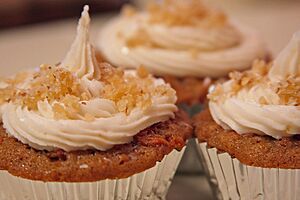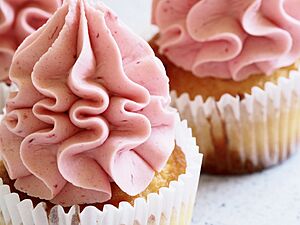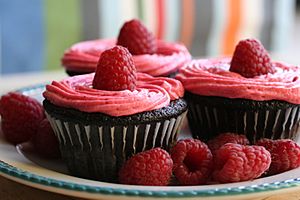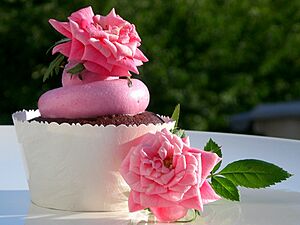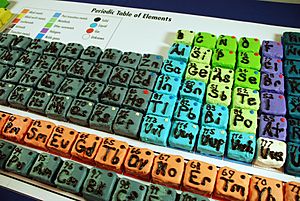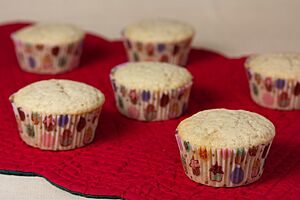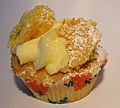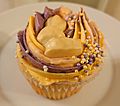Cupcake facts for kids
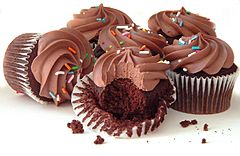
|
|
| Alternative names | Fairy cake, patty cake, cup cake |
|---|---|
| Type | Cake |
| Place of origin | United States |
| Main ingredients | Butter, sugar, eggs, flour; optionally frosting and other cake decorations |
A cupcake is a small, single-serving cake. It's usually baked in a thin paper or aluminum cup. Just like bigger cakes, cupcakes can have frosting and fun decorations like candy on top. In some places, like the UK and Australia, they are called fairy cakes.
Contents
History of Cupcakes
The idea of baking small cakes in cups goes way back! The first time a recipe mentioned "a cake to be baked in small cups" was in 1796 in a book called American Cookery. The actual word cupcake first appeared in a cookbook in 1828, written by Eliza Leslie.
In the early 1800s, people used the name cupcake for two reasons. First, before muffin tins were common, these cakes were baked in individual pottery cups or small molds. So, they got their name from the cups they were baked in. This is why we still call them cupcakes today! A cupcake is usually about the size of a teacup.
Making Cupcakes
Cupcakes use the same basic ingredients as regular cakes: butter, sugar, eggs, and flour. You can use almost any recipe for a big layer cake to make cupcakes instead. You can also add different flavors or mix-ins like raisins, berries, nuts, or chocolate chips into the batter.
Because cupcakes are small, they cook much faster than a large cake. This makes them a quick and easy treat to bake!
After baking, cupcakes are often topped with frosting or other decorations. Sometimes, they are even filled with frosting, fruit, or cream. For a few cupcakes, you can scoop out a small hole with a spoon and fill it. For many cupcakes, bakers might use a special bag or even a syringe to inject the filling. Cupcakes with fancy decorations are often made for special parties and events.
Different Kinds of Cupcakes
There are many fun ways to make and enjoy cupcakes:
- A cake in a mug is a super quick cupcake version. You mix the ingredients right in a mug and cook it in a microwave oven. It often takes less than five minutes! These cakes rise quickly because of how the oil in the mixture heats up and creates air pockets.
- A cake in a jar is another way to make cupcakes. Instead of a muffin tin, you bake the cupcake right inside a glass jar.
- A butterfly cake is a special kind of cupcake, sometimes called a fairy cake. You cut off the top of the cake, slice it in half, and then fill the hole with buttercream or whipped cream. Then, you stick the two cut halves into the cream to look like butterfly wings! These wings are often decorated with icing.
- Gourmet cupcakes are a newer trend. These are often larger and filled with different flavors, like Tiramisu or Cappuccino. In many cities, you can find special shops that sell only gourmet cupcakes.
- Sometimes, bakers arrange many standard cupcakes together and frost them to create a big picture or design. This could be a basket of flowers or even an animal!
Cupcake Pans and Liners
Long ago, cupcakes were baked in heavy pottery cups. Some people still use individual ramekins or small coffee mugs to bake them.
Today, cupcakes are usually baked in muffin tins. These pans are often made of metal and have six or twelve round spaces, or "cups." A standard cupcake cup is about 3 inches (7.6 cm) wide. You can also find pans for tiny "mini" cupcakes or extra-large "jumbo" ones.
Many bakers use individual patty cases or cupcake liners inside the muffin tin. These are usually round paper cups. Liners make it easy to take the cupcake out of the pan after baking. They also help keep the cupcake moist and make cleaning the pan much easier. Using liners is also a good idea for hygiene when many people are handling the cupcakes.
Cupcake Shops
In the early 2000s, special cupcake shops became very popular in the United States. These bakeries often sell only cupcakes, bringing back a feeling of nostalgia for many people. Some well-known cupcake shop chains include Crumbs Bake Shop and Sprinkles Cupcakes.
Cupcake Themes
Cupcakes are sometimes used to celebrate or show off specific ideas.
A fun example is the periodic table of cupcakes. This is a collection of decorated cupcakes arranged like the elements on the periodic table. Each cupcake might be flavored and colored, and then decorated with the atomic number and chemical symbol of an element. The first person to create a periodic table of cupcakes was Ida Freund in 1907. She was the first woman to teach chemistry at a university in the UK. She used the cupcakes to make learning chemistry fun for her students at Cambridge University.
Today, periodic table cupcakes are a popular and creative way to celebrate chemistry at school events and science fairs!
Classic Vanilla Cupcakes Recipe
This recipe is perfect for beginners and yields delicious, moist cupcakes every time.
Yields: 12 cupcakes| Prep time: 20 minutes | Bake time: 18-20 minutes
Ingredients:
- 1 ½ cups (190g) all-purpose flour
- 1 cup (200g) granulated sugar
- 1 ½ tsp baking powder
- ½ tsp salt
- ½ cup (1 stick / 115g) unsalted butter, softened to room temperature
- 2 large eggs, at room temperature
- ½ cup (120ml) whole milk, at room temperature
- 2 tsp vanilla extract
Instructions:
1. Preheat your oven to 350°F (175°C). Line a 12-cup muffin tin with paper liners.
2. In a medium bowl, whisk together the flour, sugar, baking powder, and salt. Set aside.
3. In a large bowl, using an electric mixer (or a stand mixer with the paddle attachment), beat the softened butter on medium speed for about 30 seconds until smooth and creamy.
4. Add the eggs one at a time, beating well after each addition. Then mix in the vanilla extract. The mixture may look slightly curdled—this is normal.
5. Add the dry flour mixture and the milk to the wet ingredients. Mix on low speed just until combined. Do not overmix; a few small lumps are okay. Overmixing leads to dense cupcakes.
6. Divide the batter evenly between the 12 muffin cups, filling each about 2/3 full.
7. Bake for 18-20 minutes, or until a toothpick inserted into the center of a cupcake comes out clean.
8. Let the cupcakes cool in the pan for 5 minutes before transferring them to a wire rack to cool completely before frosting.
Fluffy Vanilla Buttercream Frosting
Ingredients:
- 1 cup (2 sticks / 230g) unsalted butter, softened to room temperature
- 4 cups (480g) confectioners' sugar, sifted
- 2-3 tbsp heavy cream or whole milk
- 2 tsp vanilla extract
- Pinch of salt
Instructions:
1. In a large bowl, beat the softened butter with an electric mixer on medium speed for 2-3 minutes until it is very light, pale, and fluffy.
2. Gradually add the sifted confectioners' sugar, one cup at a time, with the mixer on low. Once incorporated, increase the speed to medium-high and beat for 2 minutes.
3. Add the vanilla extract, salt, and 2 tablespoons of heavy cream. Beat for another 2 minutes until smooth and fluffy.
4. If the frosting is too thick, add the remaining tablespoon of cream. If it's too thin, add a little more confectioners' sugar.
5. Once the cupcakes are completely cool, frost them using a piping bag with a tip or a simple spatula.
Pro Tips for Success:
- Room Temperature is Key: Using room temperature eggs, milk, and butter is crucial for a smooth, well-emulsified batter that rises properly.
- Don't Overmix: Once you add the flour, mix only until the ingredients are combined. Overmixing develops gluten, which makes cupcakes tough.
- Don't Overbake: Start checking at the 18-minute mark. The cupcakes are done when the tops spring back lightly when touched.
- Cool Completely: Warm cupcakes will melt the frosting into a runny mess.
Enjoy your baking!
Images for kids
-
A Hostess CupCake, showing the typical "snack cake" style of cupcake
-
Cupcakes may be plain cakes without any frosting or other decoration. These were baked on a flat baking sheet in a double-layer of paper cupcake liners
See also
 In Spanish: Cupcake para niños
In Spanish: Cupcake para niños


